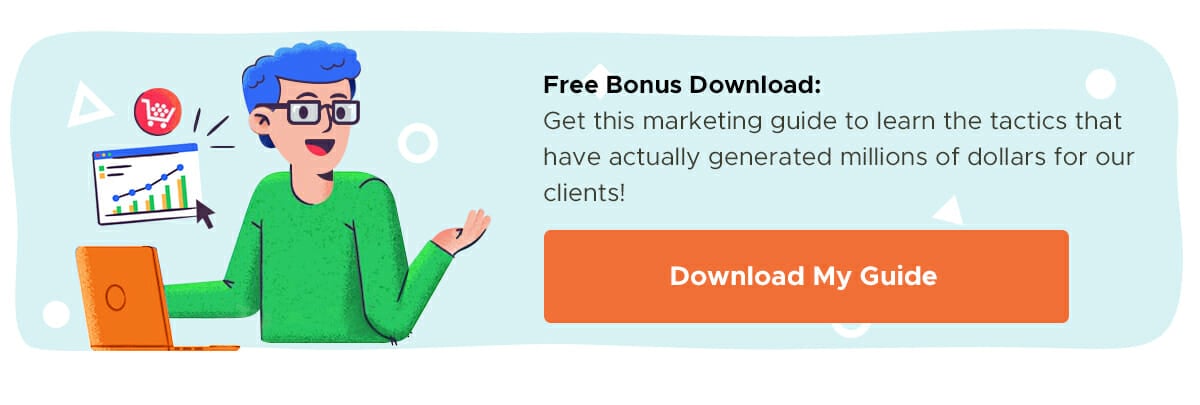There are countless ways digital advertising technology has advanced in recent years. Marketers can quickly create, test and optimize hundreds of personalized, targeted ads. Because of the many tools available to segment audiences and automatically deliver the best ads to the right people, marketers can easily scale their advertising campaigns and maximize clicks.
Google Ads, especially, has increasingly been automating their ad creation and delivery with features like Dynamic Search Ads, Ad Customizers, Automated Bidding, and more. Facebook isn’t far behind with their Automated Ads and Dynamic Creative Ads features.
Then, of course, almost all advertising platforms today provide retargeting capabilities to reach prospects who have already shown interest in a product, service or brand.
The Problem That Many Advertisers Don’t Pay Attention To
Even with all of these automated advertising options across a wide variety of ad platforms, 96% of paid ad clicks still don’t convert. This is a massive waste in the multi-billion dollar digital advertising industry, and the main reason is because Post-Click Automation has not been a focused initiative in the market. Post-click personalization and conversion technologies have been seriously lagging.
Most digital advertisers spend the majority of their time on the pre-click experience (the ad), but they need to optimize the post-click experience (landing pages) as easily as they create ads so they can turn clicks into conversions. Click To Tweet
They need to be able to move at the speed of advertising. That’s the only way to realize the full potential of today’s advertising technology.
While most technology continues to focus on improving the pre-click stage, a pivotal class of software has emerged recently to help marketers reclaim the post-click experience – Post-Click Automation software.
Dive Deeper:
What Is Post-Click Automation?
Post-Click Automation (PCA) is the category of marketing technology that maximizes advertising conversions for marketers by delivering 1:1 personalized post-click experiences at scale.
Post-Click Automation software bridges the gap between pre-click segmentation and post-click personalization – a goal that agencies recognize as crucial. In fact, when asked about the biggest advertising “game changer” in the next five years, agencies prioritized personalization as number one, tied with AI and machine learning:

While most individual solutions only focus on one single aspect of the post-click experience – tools for data collection, page creation, A/B testing or optimization – a PCA platform combines them all into one end-to-end solution.
This is ideal for agencies because they don’t require the budget for multiple tools or the resources for hiring and training employees. Instead, PCA software is designed to seamlessly integrate with current processes to deliver results quickly using four key components.
Dive Deeper:
The 4 Components of Post-Click Automation
Complete PCA platforms are built on four pillars – ad mapping, scalable creation, personalization and optimization:
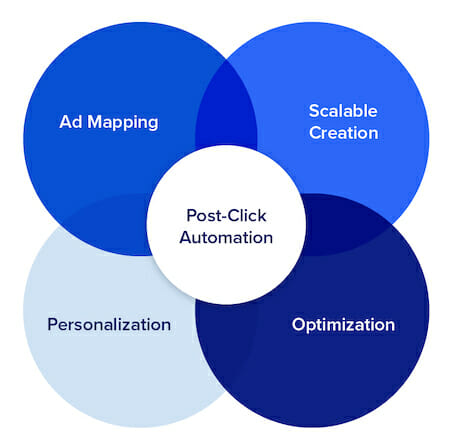
In this section, we’ll detail all four and how they each contribute and work together to improve the overall post-click experience.
1) Ad Mapping
This is a major component of the post-click experience, because it allows marketers to focus more on strategy and less on tedious, repetitive daily tasks.
Currently, most PPC marketers download campaign information to a spreadsheet and manually map their ads to post-click landing pages. This process makes it extremely difficult to assess the number of post-click pages needed per campaign, log the updates made to each page, and keep message match consistent between each page and ad.
PCA platforms are uniquely built for PPC marketers to visualize the entire advertising funnel, and are equipped with the ability to connect ad networks to specific post-click landing page experiences. This way, advertisers can save time and remain more organized in determining which ad/ad group connects to each page.
2) Scalable Creation
One of the biggest obstacles to optimizing the post-click stage is creating enough pages to deliver a relevant post-click experience.
Every promotion needs its own post-click page. That means that if you have four different audience segments within a campaign, you should have a separate post-click landing page for each one to truly provide a relevant experience from start to finish. The more relevant each page is to the visitor, the lower your bounce rate and the better the chance you have of converting them.
For an agency serving many clients, though, simultaneously running individual campaigns per audience segment isn’t something that’s often considered. The work it takes to create one page can span days if it’s built from scratch, so creating multiple pages from scratch in a timely manner seems nearly impossible.
Creating one post-click page per audience segment is only possible with a solution that allows for easy scaling, and that’s exactly what Post-Click Automation platforms do.
They offer:
- Intuitive builders, enabling even non-technical employees to publish a page in minutes
- Fully customizable templates, pre-built with conversion-centered design
- Page blocks that provide the capability to create pages faster than ever
- Manual editing, so any user can make single changes to one page, like adding a widget or adjusting a headline
- Global scaling, which allows users to make widespread changes from a single place
Example: If you discover through testing that a form is too long, you can quickly and easily reduce the number of form fields on every page where that form exists. Manually, this would take far too long to accomplish, but with a PCA platform, it can be done in seconds.
3) Personalization
Creating one post-click page per campaign or audience segment is one thing, but personalizing each one is another. Without digital advertising personalization, especially in the post-click stage, you run the risk of lower conversion rates.
To provide a post-click experience that’s just as relevant as the pre-click experience, each page must match the audience and message of its referring ad or email. This includes its language, media, colors and, most importantly, the overall offer.
Example: Airbnb created two separate ad campaigns: one for New York and one for San Francisco. Prospects probably expect to be directed to a page tailored to their specific location upon clicking the ad. However, everyone lands on the same generic page, which completely lacks post-click advertising personalization:
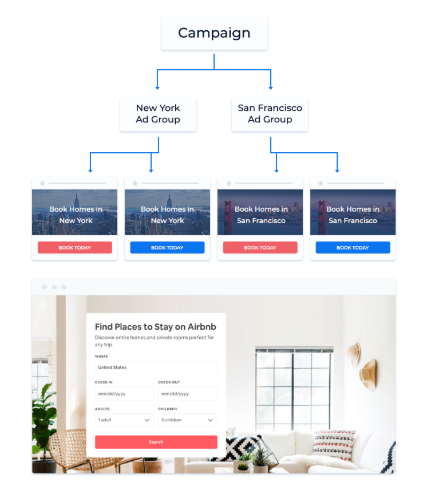
Instead, each experience should match the ad based on geo-location:
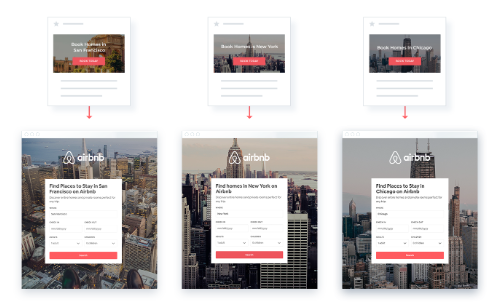
Advertising personalization through message match accomplishes three things:
- Trust: When audiences arrive at a page that matches the ad they clicked on, they know they’re in the right place.
- Brand identity: The more on-brand your pages are, the stronger and more recognizable your brand becomes, and the more your offers are consumed.
- Positive user experience: Relevance between ad and post-click page makes it easier for prospects to evaluate your offer. There’s no scouring links and navigation menus to access the resource you promised in the pre-click stage.
Without Post-Click Automation software, edits to match each advertisement would take far too much time. With PCA, everything from colors to logos to text to widgets, etc., are quickly and easily editable, allowing agencies to keep their client post-click landing pages personalized and on-brand.
Dive Deeper:
4) Optimization
The last pillar of Post-Click Automation is optimization. This refers to all activities that contribute to improving the post-click experience – data collection, analysis, testing, editing, etc. No Post-Click Automation platform is complete without all of them.
At the same time, there’s no scalable way for an agency to improve their conversion rates without optimization. That’s where both qualitative and quantitative methods of data collection come into play, including:
- Heat maps to track scroll depth, clicks, and mouse movement
- Analytics dashboards to track traditional metrics like average cost per visitor ad lead, total visitors, conversions, etc.
- A/B testing to test various elements, page speed, etc., of different pages to see which converts better for a common goal
PCA platforms come equipped with all of these, allowing users to collect data on page design and test different approaches to conversion. Brands also need the service component, though, which is where agencies come into play.
Dive Deeper:
Why Should Agencies Offer PCA as a Service to Clients?
No successful agency is retained for the services it provides, but rather, the services it provides well.
Agencies without a large staff and budget were once prevented from providing Post-Click Automation services. And since post-click results are a bigger effector of churn than pre-click results, this put small to medium-sized agencies at the mercy of their clients.
If, by chance, you had a client who understood the importance of the post-click stage, you were set up for a good relationship. However, if your client didn’t prioritize the post-click experience, then you were likely let go.
Today, agencies of all sizes can take control of their fate with a Post-Click Automation platform. While this enables better client retention (a bigger producer of profits than acquisition) through the accomplishment of key performance goals, it also helps tremendously with acquisition.
Still, according to the 2018 Marketing Agency Growth Report, neither conversion rate optimization nor Post-Click Automation are a top offering from agencies:
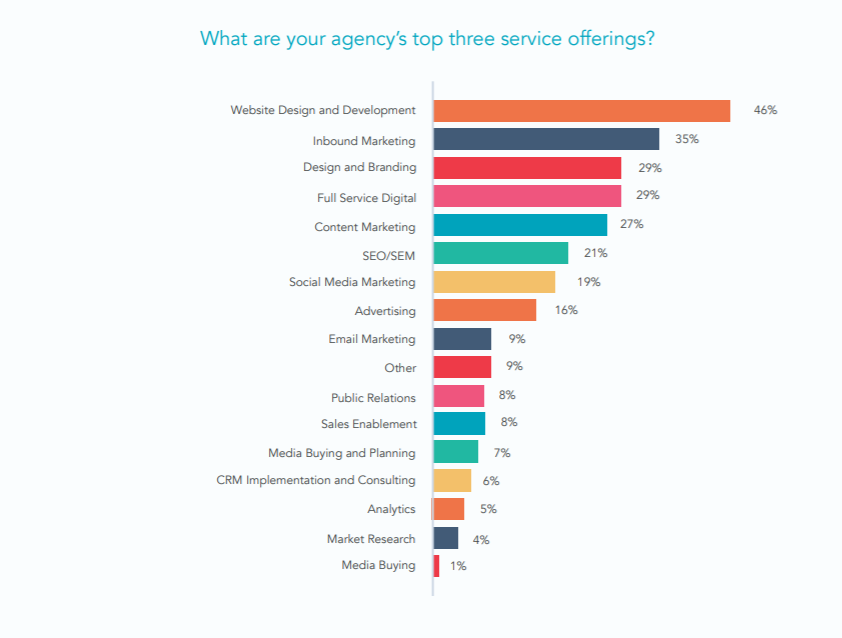
This puts an agency who does offer the service in the unique position of providing something that others don’t. A unique selling proposition like this can be the deciding factor for a client evaluating multiple agencies.
Of course, agencies can also use Post-Click Automation services for their own benefit. According to another section of the HubSpot report, finding new clients is the biggest pain point for agencies:
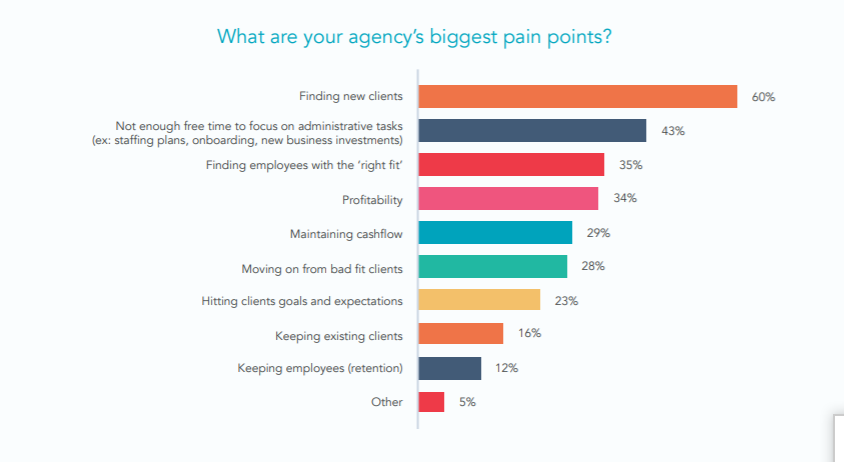
And finding new clients leads to an increased focus on, and investment in, lead generation:
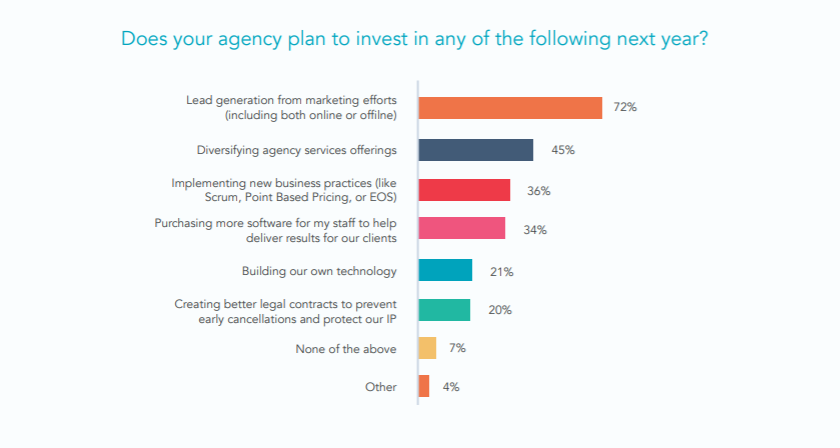
Lead generation, although a top-of-funnel goal, cannot be accomplished without an optimized post-click experience. Therefore, an investment in Post-Click Automation software could be exactly what an agency needs to stand out in an increasingly crowded landscape.
Add Post-Click Automation Services to Your Arsenal
By offering Post-Click Automation to clients, you’ll differentiate your agency from the competition. You’ll show them that with automation, scalable creation, personalization and optimization, you can drive more conversions for their campaigns, while saving them time and money.
It doesn’t stop there, though. With PCA services in your arsenal, you’ll also generate more new clients for yourself, enjoy a higher retention rate, and retake control of your success in the process.
